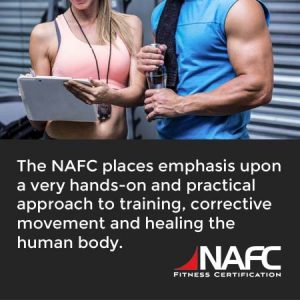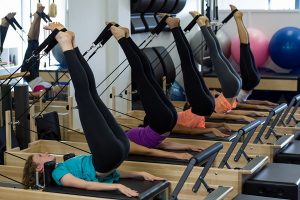Pilates Coach Reformer 1 Certification Information
Getting Started
What You Will Learn
Objectives
Getting Started

Prerequisites:
- Minimum GED or High School Diploma required.
- You must be18 years of age or older.
- You must have and maintain a CPR/AED certification.
Course Education Level: Intermediate
Continuing Education Credits: 2.5 NAFC, 2.5 IACET
How it Works:
To earn this certification…
- You must complete all course modules.
- You must take and pass all required examinations with a score of 80% or higher.
- Time to Complete: You have up to 18 Months to complete Examination Process
- Course Access: Continued access with updates available
Certification Process:
- Your NAFC Pilates Coach Reformer 1 Certification is valid for 24 months. During that 24 months you must complete continuing education prior to your renewal date to qualify for re-certification.
- Recertification is required to keep you up to date with industry standards and practice. You must complete and submit 15 hours (1.5 NAFC credits) of continuing education in a 24 month period of time prior to your renewal date and complete a re-certification application to be recertified.
Click Here for System Requirements to View and Complete this Course.
What You Will Learn
 Pilates Reformer 1 Required Course Material:
Pilates Reformer 1 Required Course Material:
- Foundations of Fitness and Exercise Online Course (50 Question Exam)
- Pilates Coach Foundations of Movement Online Course (35 Question Exam)
- Pilates Coach Reformer 1 PDF Manual ( 50 Question Certification Exam)
- Pilates Reformer Virtual Workshop (9 videos)
Practical Requirement:
- You are required to log and complete 30 hours of practical experience
- You are required to complete a Practical Exam
Objectives
Foundations of Fitness and Exercise
After completing this course you will be able to:
- Identify 8 cardiovascular risk factors and their relationship to health.
- Describe lifestyle disease, preventive medicine, and the concept of exercise as medicine.
- Describe the 5 components of fitness and the role genetics plays in exercise.
- Identify the 12 organ systems and major bones, joints, and muscles and their properties in the human body.
- Identify 9 anatomical reference and 12 anatomical movement terms to describe human movement.
- Describe the role of levers and planes of motion in human movement.
- Discuss 6 principles of exercise training.
- Describe how the 3 energy systems work in the body.
- Identify basic agonist muscle action in 8 areas of the body.
- Describe agonist/antagonist muscle action in gravity for 12 movements.
- Describe the 5 parts of the NAFC ANSER™ acronym.
Pilates Coach: Foundations of Movement
After completing this course you will be able to:
- Define Pilates and discuss the history and benefits of Pilates.
- Describe the anatomy and function of the core.
- Compare three types of flexibility training.
- Explain the importance and 4 steps for medical clearance for exercise for students/clients/special populations.
- Identify proper breathing, 4 common mistakes in breathing, the Scoop, and Wave.
- Describe the 2 components of breathing and 3 exercises to help teach proper breathing.
- Explain how to find neutral pelvis and neutral spine and the role of the psoas in exercise.
- Recognize how to properly assess and correct posture, gait, foot pronation/supination, and common postural shifts for students/clients.
- Recognize 3 abnormalities in knee position, lower cross syndrome, upper cross syndrome, crossed pelvis syndrome, and Pilates exercise to help correct these postural deviations.
- Explain how to safely and effectively perform 10 Pilates supine exercises.
- Explain how to safely and effectively perform 3 prone and 3 side lying Pilates exercises.
- Explain how to safely and effectively perform 5 Pilates hands and knees exercises.
- Explain how to safely and effectively perform 4 Pilates seated exercises and 1 standing exercise.
Pilates Reformer 1
After completing this course you will be able to:
- Identify 7 guidelines for coaching Pilates reformer exercises.
- Recognize different types of reformers and 9 characteristic parts found on a reformer.
- Discuss 12 important reformer safety guidelines.
- Recognize 2 postural deviations that may require adjustments for Pilates reformer exercises.
- Discuss 11 reformer guidelines for safe and effective use of the Pilates reformer.
- Explain proper breathing techniques in 3 body positions.
- Identify 9 variations for foot positioning on the Pilates reformer.
- List 5 recommendations for safe and effective practice when using a ball as a prop for the Pilates Reformer.
- Explain how to safely and effectively perform 3 Pilates reformer warm up exercises.
- Explain how to safely and effectively perform 4 Pilates reformer supine exercises.
- Explain how to safely and effectively perform 4 Pilates reformer abduction/adduction exercises.
- Explain how to safely and effectively perform 8 Pilates reformer upper body exercises.
- Explain how to safely and effectively perform 2 Pilates reformer prone exercises.
- Explain how to safely and effectively perform 2 Pilates reformer exercises Sitting on the short box.
- Explain how to safely and effectively perform 2 Pilates reformer abdominal exercises
Reformer 1 Certification
CERTIFICATION
Pilates Coach Reformer 1
$499
Online Interactive Foundations of Fitness and Exercise Course
Online Interactive Pilates Coach Foundations of Movement Course
PDF Manual Pilates Reformer 1 Course
Virtual Video Workshop
Virtual Flash Cards
Online Exams with Immediate Results
Educational Support
Career Assistance
IACET Accredited Certification
Reformer 1 Workshop
November 8, 2025: 9am-6pm
November 9, 2025: 8am-5pm
The Studio by EscalonFit
1735 Main St
Escalon, CA 95320

